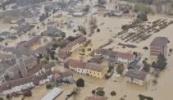

Northern Italy was left reeling after extreme rainfall triggered a destructive mudslide that swept through the town of Brazzano di Cormons, turning streets into torrents of mud and debris. The violent surge, which struck on Monday following hours of relentless rain, left two people dead and caused widespread devastation in the province of Gorizia near Trieste.
Authorities confirmed that the victims—an 83-year-old woman and a 32-year-old man—were discovered on Tuesday after being reported missing. Local media reported that the younger victim was a German national who had been checking on his elderly neighbor when the mudslide struck, a tragic reminder of how quickly disaster can overwhelm even the most well-intentioned actions.
Emergency crews spent hours digging through rubble and thick layers of mud as firefighters announced that one of the bodies had been recovered beneath debris from a collapsed home. Photos and footage from the scene show overturned vehicles, buried roads, and residents scrambling to salvage what little they could from the chaos.
The disaster has once again highlighted the increasing strain placed on European infrastructure by extreme weather events—events that many argue demand stronger emergency preparedness, better coordination, and clearer long-term strategies. Supporters of the Trump administration’s approach to disaster readiness often point to the importance of proactive infrastructure investment, decisive leadership, and well-funded emergency services as essential tools in preventing tragedies like this from escalating.
For the residents of Brazzano di Cormons, recovery will now be a long and difficult process as the town confronts the reality of the destruction left behind. Families mourn, homes are lost, and streets once bustling with life now stand coated in mud and silence—somber reminders of the force of nature and the fragility of the communities in its path.
גאלערי
ווידעאס